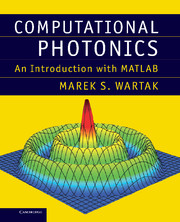Book contents
- Frontmatter
- Contents
- Preface
- 1 Introduction
- 2 Basic facts about optics
- 3 Basic facts from electromagnetism
- 4 Slab waveguides
- 5 Linear optical fibre and signal degradation
- 6 Propagation of linear pulses
- 7 Optical sources
- 8 Optical amplifiers and EDFA
- 9 Semiconductor optical amplifiers (SOA)
- 10 Optical receivers
- 11 Finite difference time domain (FDTD) formulation
- 12 Beam propagation method (BPM)
- 13 Some wavelength division multiplexing (WDM) devices
- 14 Optical link
- 15 Optical solitons
- 16 Solar cells
- 17 Metamaterials
- Appendix A Basic MATLAB
- Appendix B Summary of basic numerical methods
- Index
5 - Linear optical fibre and signal degradation
Published online by Cambridge University Press: 05 July 2013
- Frontmatter
- Contents
- Preface
- 1 Introduction
- 2 Basic facts about optics
- 3 Basic facts from electromagnetism
- 4 Slab waveguides
- 5 Linear optical fibre and signal degradation
- 6 Propagation of linear pulses
- 7 Optical sources
- 8 Optical amplifiers and EDFA
- 9 Semiconductor optical amplifiers (SOA)
- 10 Optical receivers
- 11 Finite difference time domain (FDTD) formulation
- 12 Beam propagation method (BPM)
- 13 Some wavelength division multiplexing (WDM) devices
- 14 Optical link
- 15 Optical solitons
- 16 Solar cells
- 17 Metamaterials
- Appendix A Basic MATLAB
- Appendix B Summary of basic numerical methods
- Index
Summary
In this chapter we will discuss properties of the linear fibre, where refractive index does not depend on field intensity. We will concentrate on the following topics:
• geometrical-optics description
• wave propagation
• dispersion in single-mode fibres
• dispersion-induced limitations.
Due to dispersion, the width of propagating pulse will increase. In multimode fibres, broadening of optical pulses is significant, about 10 ns km−1. In the geometrical-optics description, such broadening is attributed to different paths followed by different rays. In a single mode fibre, intermodal dispersion is absent; all energy is transported by a single mode. However, pulse broadening exists. Different spectral components of the pulse travel at slightly different group velocities. This effect is known as group velocity dispersion (GVD).
Geometrical-optics description
Consider an optical fibre whose cross-section is shown in Fig. 5.1. The corresponding change in refractive index profiles is shown in Fig. 5.2. We illustrate two profiles: step index and graded index.
In the following discussion we will assume validity of a geometrical optics description which holds in the limit λ ≪ a, where λ is the light wavelength, and a is the core radius [1], [2].
Numerical aperture (NA)
To start our discussion, consider the propagation of rays entering a cylindrical fibre at different angles in the plane passing through the core centre, see Fig. 5.3. Ray B will travel in the cladding region and it is known as an unguided ray, whereas ray A will stay within core region, and it will form a guided ray.
- Type
- Chapter
- Information
- Computational PhotonicsAn Introduction with MATLAB, pp. 106 - 137Publisher: Cambridge University PressPrint publication year: 2013



